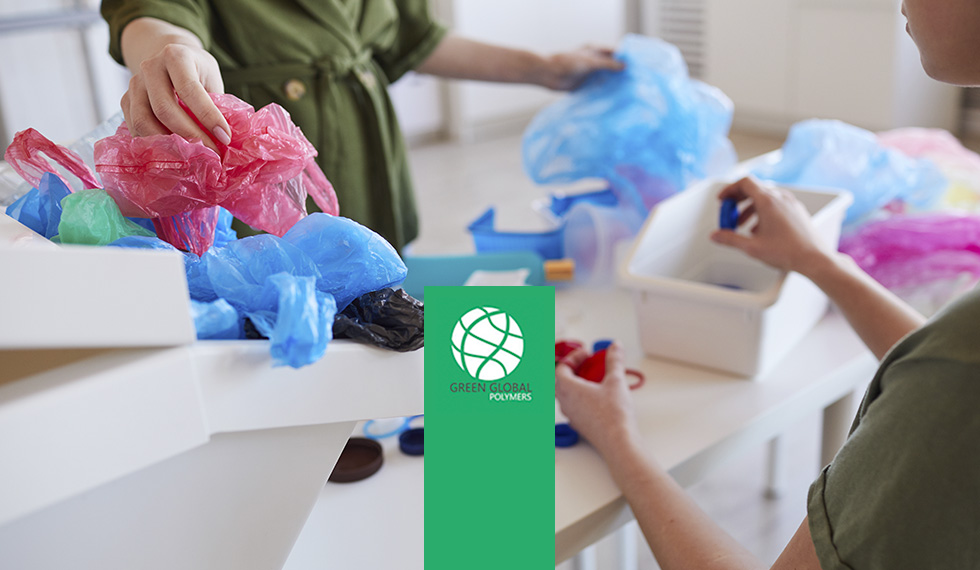Tipos de plásticos que reciclamos y sus aplicaciones

En GREEN GLOBAL POLYMERS, nos dedicamos a la comercialización y recuperación de diversos tipos de materiales plásticos, incluyendo PP, PEHD, PELD, PET, PVC y PS. Con más de 30 años de experiencia en el sector, combinamos la tradición con la innovación, representada por nuestra segunda generación de profesionales. Nos enfocamos en el recuperado, reciclaje y comercialización de plásticos, trabajando incansablemente para dar nueva vida a los desechos plásticos y convertirlos en recursos útiles.
Nuestra planta de recuperación, ubicada en la Avenida del Transporte, 45 – A PI Ribarroja, sector 13, 46394 Ribarroja del Túria (Valencia), cuenta con una línea de lavado y triturado que garantiza productos de alta calidad. Aquí, desglosamos los tipos de plásticos que reciclamos y sus aplicaciones:
Polipropileno (PP)
El polipropileno es uno de los plásticos más comunes en el mercado debido a su versatilidad y resistencia. En GREEN GLOBAL POLYMERS, reciclamos polipropileno, transformándolo en productos que pueden ser reutilizados en diversas industrias.
Aplicaciones del Polipropileno reciclado:
- Envases y embalajes: Utilizado en la fabricación de envases para alimentos y bebidas, y en empaques para productos diversos.
- Automoción: Se usa en la producción de componentes automotrices como parachoques y paneles interiores.
- Construcción: Empleado en la creación de tuberías y sistemas de ventilación.
- Textiles: En la elaboración de fibras y tejidos no tejidos para alfombras y ropa.
Polietileno de alta densidad (PEHD)
El polietileno de alta densidad es conocido por su alta resistencia y durabilidad. En nuestra planta, reciclamos PEHD para fabricar productos robustos y reutilizables.
Aplicaciones del PEHD reciclado:
- Botellas: Comúnmente utilizado en botellas para detergentes, aceites y otros líquidos.
- Tuberías: Ideal para tuberías de agua y gas debido a su resistencia.
- Contenedores: Fabricación de contenedores industriales y agrícolas.
- Film y Láminas: Utilizado en la producción de películas y láminas plásticas para embalaje.
Polietileno de baja densidad (PELD)
El polietileno de baja densidad es flexible y tiene una amplia gama de aplicaciones. En GREEN GLOBAL POLYMERS, reciclamos PELD para producir materiales útiles y sostenibles.
Aplicaciones del PELD reciclado:
- Bolsas: Producción de bolsas de plástico para supermercados y tiendas.
- Películas para Agricultura: Usado en cubiertas de invernaderos y mantillos.
- Embalaje: En el embalaje de productos diversos, incluyendo alimentos.
- Recubrimientos: Aplicado en recubrimientos protectores para cables eléctricos.
Polietileno tereftalato (PET)
El polietileno tereftalato es ampliamente utilizado en envases de bebidas y alimentos debido a su transparencia y durabilidad. Reciclamos PET para reducir el impacto ambiental de los residuos plásticos.
Aplicaciones del PET reciclado:
- Botellas: Reutilizado para fabricar nuevas botellas de bebidas y alimentos.
- Fibras Sintéticas: Utilizado en la producción de fibras para textiles y alfombras.
- Bandejas y Envases: En la fabricación de bandejas y envases para alimentos.
- Láminas y Películas: Producción de láminas y películas para embalaje.
Policloruro de vinilo (PVC)
El policloruro de vinilo es un plástico versátil usado en una variedad de aplicaciones industriales y comerciales. En GREEN GLOBAL POLYMERS, reciclamos PVC para prolongar su vida útil y reducir los desechos.
Aplicaciones del PVC reciclado:
- Tuberías: Utilizado en la fabricación de tuberías para construcción y agricultura.
- Materiales de Construcción: En la producción de ventanas, puertas y revestimientos.
- Productos Médicos: Usado en la fabricación de productos médicos como tubos y bolsas de sangre.
- Mobiliario: Fabricación de muebles y artículos de decoración.
Poliestireno (PS)
El poliestireno es un plástico común en envases y productos desechables. En nuestra planta, reciclamos PS para reducir su impacto en el medio ambiente y darle nuevas aplicaciones.
Aplicaciones del Poliestireno reciclado:
- Embalajes: Utilizado en la producción de bandejas y envases para alimentos.
- Aislamiento: En la fabricación de materiales de aislamiento para construcción.
- Productos de Consumo: Producción de productos desechables como vasos y platos.
- Componentes Electrónicos: Usado en la fabricación de componentes y carcasas para electrónicos.
Nuestro compromiso con el reciclaje y la sostenibilidad
En GREEN GLOBAL POLYMERS, nuestra filosofía se basa en el aprovechamiento del plástico desechado mediante un proceso de reciclaje que produce dos productos finales: plástico triturado y granzas de plástico. Estas granzas son comercializadas para la fabricación de nuevos productos, promoviendo así la economía circular y la conservación de recursos.
Estamos comprometidos con un futuro más sostenible y verde. Conscientes de los desafíos ambientales actuales, como el cambio climático y la escasez de recursos, nos dedicamos a contribuir a solucionar estos problemas mediante el reciclaje de plásticos. Trabajamos en estrecha colaboración con nuestros clientes y socios para fomentar prácticas sostenibles y responsables.
Innovación y tradición
Como empresa familiar, combinamos la tradición con la innovación. Representados por nuestra segunda generación de profesionales, en GREEN GLOBAL POLYMERS nos esforzamos por estar a la vanguardia de la tecnología de reciclaje, utilizando procesos avanzados y sostenibles para garantizar la máxima eficiencia y calidad.
Operamos una planta de recuperación equipada con una línea de lavado y triturado, lo que nos permite ofrecer productos de alta calidad y cumplir con las necesidades de nuestros clientes. Nuestro objetivo es minimizar el impacto ambiental y maximizar la reutilización de materiales plásticos.
Somos expertos en reciclaje de plástico
En GREEN GLOBAL POLYMERS, creemos que el reciclaje de plásticos es crucial para la preservación del medio ambiente y la conservación de recursos. Cada tipo de plástico que reciclamos tiene aplicaciones específicas que ayudan a reducir el desperdicio y fomentar la economía circular.
Nuestra dedicación a la sostenibilidad se refleja en cada aspecto de nuestro negocio, desde la recuperación de plásticos hasta la comercialización de granzas de alta calidad. Invitamos a todos a unirse a nosotros en este esfuerzo por construir un mundo más verde y limpio para las generaciones futuras.
Gracias a nuestra experiencia y compromiso, seguimos siendo líderes en la industria del reciclaje de plásticos, contribuyendo activamente a un planeta más sostenible y demostrando que la innovación y la responsabilidad ambiental pueden ir de la mano.



